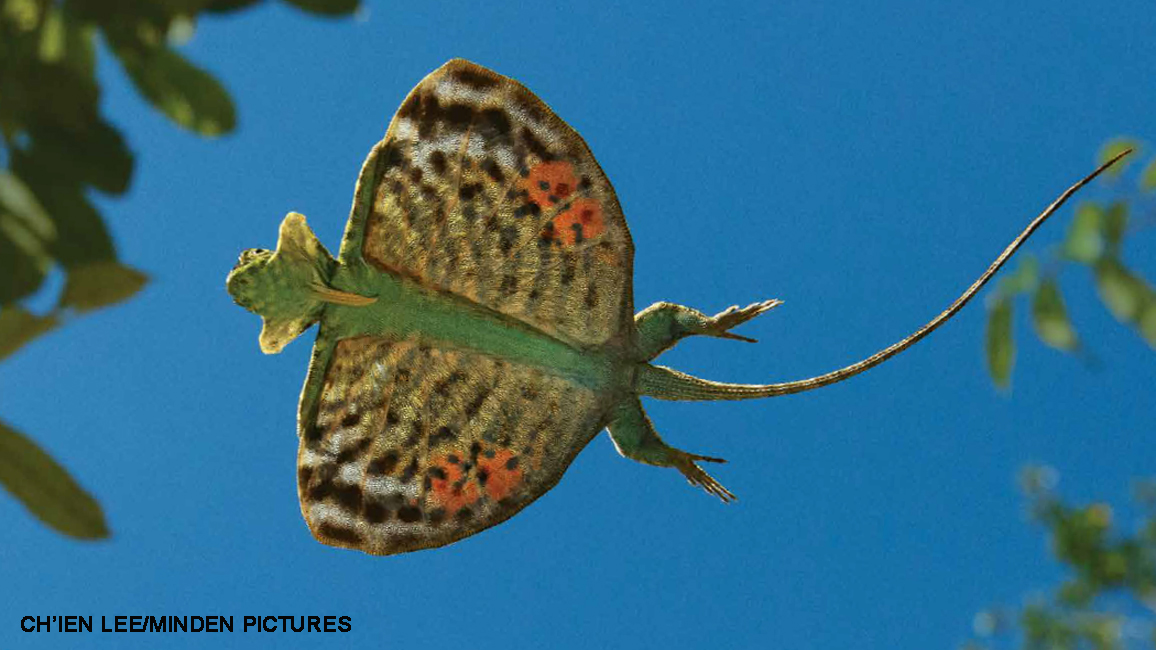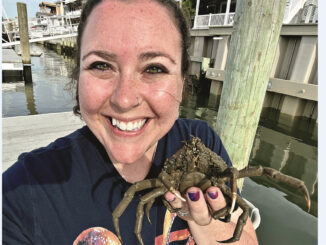
Glide On
By Kate HofmannIt’s no surprise to see birds, bats, and bugs fly. But what’s this—a flying lizard?!

If you jumped out of a tree, you’d plummet straight to the ground, right? (Ouch!) If you could fly, you’d just flap your wings and take off. But there’s one more possibility: You could glide smoothly down, coming in for a gentle landing on the ground or another tree nearby. And that’s exactly how some animals sail through the sky.
Unlike flying, gliding isn’t powered by flapping wings. Instead, the animal has body parts that allow it to glide through the air in a controlled downward motion. From lizards, frogs, and even snakes to flying squirrels, let’s meet the gliders of the world.
LIZARD ALOFT
The horned flying lizard doesn’t actually fly—it glides. See its large wing-like skin flaps? Called patagia (puh-TAY-jee-uh), those usually lie flat against its sides. But when the lizard leaps out of a tree, the patagia pop open like an umbrella. Steering with its tail, it can glide more than 100 feet from tree to tree. That’s a great way to get around as it hunts for ants and termites in the rainforests of Southeast Asia.
FEATHERED GLIDERS
Gliding isn’t just for animals that can’t fly. Birds glide, too. The albatross is a master glider. This large seabird can soar above the waves for days without once landing on the water to rest. That’s because it glides more than it flies. The bird rides the ocean winds on its long, narrow wings, flapping once in a while for extra lift and using hardly any energy.

FLYING FEET
Some frogs have webbed feet for swimming. But this one, the Wallace’s flying frog, has webbed feet for sailing through the air! Each foot acts as a mini-parachute. The tip of each toe is sticky, so the frog can make non-slip landings on tree trunks and branches.
These frogs hatch from eggs in pools on the ground. But then they climb up into the tree canopy and almost never go back down to the ground except when it’s mating time.
SNAKES SET SAIL
OK, so there are gliding lizards and gliding frogs. But gliding snakes? It’s true. The paradise tree snake glides from tree to tree in search of lizards to eat. It climbs to the tip of a branch, hangs by its tail, lifts its head, and pushes off. Then it spreads its ribs until its body is very flat and flutters through the air like a ribbon.
FISH OUT OF WATER
The fins of a flying fish look a lot like wings. But they are for gliding, not true flight. To escape from a bigger fish that might eat it, a flying fish launches its torpedo-shaped body out of the water. It flaps its tail back and forth along the water’s surface to get airborne. Then it glides with its wing-like fins. This amazing fish can stay above the water for the length of three football fields!

BIG-EYED GLIDER
The sugar glider is a gliding possum that lives in and near Australia. Those big eyes help it see in the dark as it moves around at night. Like a flying squirrel, it has a flap of skin (patagium) between each front and back leg that flares out for gliding. But sugar gliders are marsupials (mar-SOO-pee-uhlz), which means the moms carry their babies in pouches—even while zooming through the air! Gliding helps them escape enemies and search for the sweet sap and nectar they eat.
SOARING SQUIRREL
If you’re out after dusk, you might be lucky enough to see a flying squirrel traveling between trees. First, the squirrel leaps off a branch (1). Then it spreads its legs to open its furry patagium that catches the air (2). To slow down before landing, it cups the patagium and uses its tail to pull its body up (3). Finally, it reaches out with its four feet, all set to land on a tree (4). Then the squirrel often scurries around to the other side of the trunk to hide from any enemies that may have spotted it sailing through the night sky.
VIDEO: WATCH A SOARING SQUIRREL!
GO, COLUGO!
The least-known glider of all may be the colugo (kuh-LOO-goh). It’s also called a flying lemur, but it’s not a true lemur. A colugo often climbs upside down along tree branches like a sloth. But when the colugo wants to move to a new tree, its huge patagium opens wide for a glide. It has the largest patagium of any glider, stretching from its jaw to its fingers to its toes and finally to the tip of its tail.
Flying is fantastic, but it’s not for everyone. Gliding is another great way to go!
















